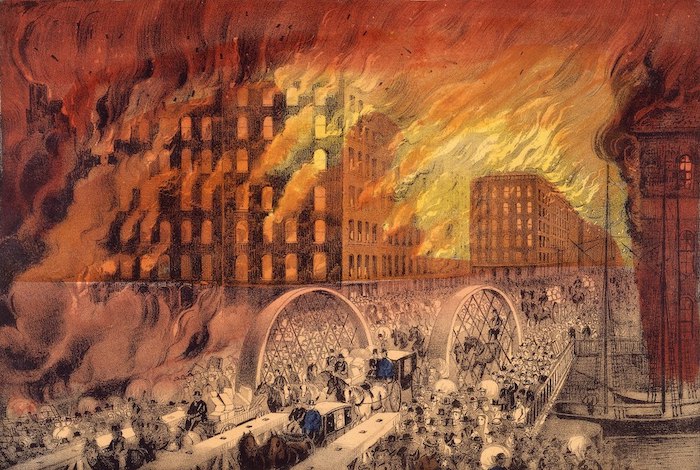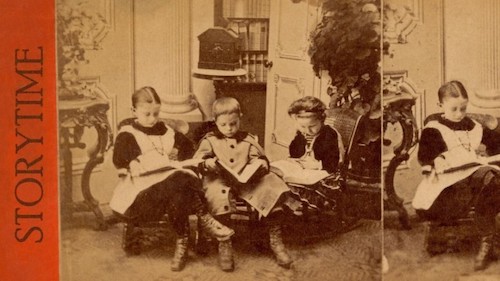150 Years Since the Chicago Fire – Marking The Anniversary Through Art

By CGN Staff
The Great Chicago Fire began on the evening of October 8, 1871 and raged for two more days.
The fire is a legend around the world, the stuff of stories and history books, far from the reach of modern day life, though we live its after effects every day without even knowing it.
Around the city several arts institutions are marking the century and a half since fire through immersive, creative exhibits. Some highlights and related shows are below.

Chicago History Museum
The Chicago History Museum has been under construction for months now but is reopening in time to mark the anniversary of the Great Chicago Fire and to welcome visitors back to new spaces and an expansive exhibition covering the history of the fire itself.
Chicago's busy streets were taken over by flames for three days, overwhelming a city built of wood and causing severe destruction. After the fire died, recovery efforts exposed deep social and economic inequalities when more than 100,000 people became homeless, and society placed blame upon the Irish immigrant O'Leary family. The devastation also sparked change and regrowth in Chicago by introducing new fire safety guidelines and rebuilding as the resilient city known today.
One hundred and fifty years later, City on Fire: Chicago 1871 guides visitors through the crucial events and conditions before, during, and after the fire—many of which draw striking comparisons to today's social climate. This family-friendly exhibition features more than 100 artifacts from the Chicago History Museum's collection, interactive and multimedia elements, and personal stories from survivors of the fire. The exhibition is designed for families to learn, explore, and discover the impact the Great Chicago Fire had on the city and the people who lived here. Featured in the City on Fire: Chicago 1871 exhibition is a 40-feet-long painting study created as a guide for a larger Chicago Fire Cyclorama painting, which was displayed in Chicago in 1892-93 in a round building constructed for visitors to have an immersive experience.
Full exhibition info available at the museum's special website Chicago1871.org

Part of the museum's Story Time: Fiery Night on Saturday, October 9 at 9:30 am and 11:00 am.
A child-friendly introduction to the Great Chicago Fire in a historic setting. Guess who’s coming to the Marble Palace for tea? Chicago’s own Mrs. Catherine O’Leary and the Nickersons’ neighbor, Mrs. Anna Tree! History comes alive during Story Time as kids meet these historical figures to hear a personal account of their experiences in 1871 and about the fire that changed everything. Mrs. Tree will recall one unforgettable incident through a reading of Fiery Night: A Boy, His Goat, and the Great Chicago Fire, by Sally M. Walker and Kayla Harren - a true story of strength, courage, and love that is part of the history of the Driehaus Museum neighborhood.
BUY TICKETS $15 for one adult and child; $5 for each additional child
Wrightwood 659
On view now is Romanticism to Ruin: Two Lost Works of Sullivan and Wright, an exhibition that attempts to conjure the essence of two long-gone masterpieces. Louis Sullivan’s Garrick Theatre Building in Chicago stood for only sixty-nine years and Frank Lloyd Wright’s Larkin Building in Buffalo lasted only forty-four years,
The Great Chicago Fire actually had an impact on the design of the Larkin Building in Buffalo, NY, some 30 years later.
The threat of fire held a special significance for John D. Larkin, who was an eyewitness to the vast destruction of the Chicago fire of 1871. The original Larkin & Weller soap-manufacturing business was located on Halsted Street in Chicago, a couple of blocks from the edge of the fire. Larkin insisted that Frank Lloyd Wright design an "absolutely fire-proof construction." In response, Wright created a steel-framed building that was clad in brick inside and out. Of course in the end, it wasn't fire that destroyed the Larkin Building, but mankind's blinding urge for "progress," resulting in the 1950 demolition of Wright’s masterpiece to make room for a truck barn.






